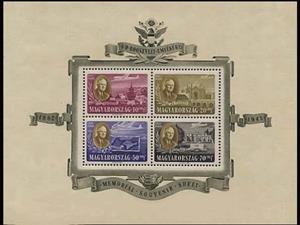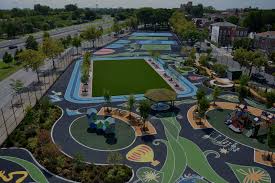Souvenir Sheet: Air mail, F. D. Roosevelt, miniature sheet (Hungary 1947)
Air mail, F. D. Roosevelt, miniature sheet (Hungary 1947)
11 June (Hungary ) within release In Memoriam F. D. Roosevelt goes into circulation Souvenir Sheet Air mail, F. D. Roosevelt, miniature sheet face value 150+150 Hungarian fillér
| Souvenir Sheet Air mail, F. D. Roosevelt, miniature sheet in catalogues | |
|---|---|
| Michel: | Mi:HU BL11 |
Souvenir Sheet is horizontal format.
With stamps HU989/992Also in the issue In Memoriam F. D. Roosevelt:
- Stamp - Freedom of Speech face value 8+8;
- Stamp - Freedom of Religion face value 12+12;
- Stamp - Freedom from Want face value 20+20;
- Stamp - Freedom from Fear face value 30+30;
- Stamp - Casablanca face value 10+10;
- Stamp - Teheran face value 20+20;
- Stamp - Yalta face value 50+50;
- Stamp - Hyde Park face value 70+70;
- Souvenir Sheet - F. D. Roosevelt, miniature sheet face value 70+70;
- Souvenir Sheet - Air mail, F. D. Roosevelt, miniature sheet face value 150+150;
- Stamp - Freedom of Religion face value 12+12;
- Tete-Beche - Freedom from Want face value 2*(20+20);
- Souvenir Sheet - Freedom from Want face value 25*(20+20);
- Souvenir Sheet - Freedom from Want face value 25*(20+20);
- Souvenir Sheet - Freedom from Want face value 4*(20+20);
- Souvenir Sheet - Freedom from Want face value 4*(20+20);
- Souvenir Sheet - In Memory of F. D. Roosevelt face value 150+150;
- Souvenir Sheet - In Memory of F. D. Roosevelt face value 70+70;
- Stamp - F.D. Roosevelt, Plane, Casablanca face value 10+10;
- Stamp - F.D. Roosevelt, Plane, Casablanca face value 10+10;
- Stamp - F.D. Roosevelt, Plane, Casablanca face value 10+10;
- Full Pane - F.D. Roosevelt, Plane, Casablanca face value 25*(10+10);
- Souvenir Sheet - F.D. Roosevelt, Plane, Casablanca face value 4*(10+10);
- Souvenir Sheet - F.D. Roosevelt, Plane, Casablanca face value 4*(10+10);
- Tete-Beche - F.D. Roosevelt, Plane, Casablanca face value 2*(10+10);
- Stamp - F.D. Roosevelt, Plane, Hyde Park face value 70+70;
- Stamp - F.D. Roosevelt, Plane, Hyde Park face value 70+70;
- Stamp - F.D. Roosevelt, Plane, Hyde Park face value 70+70;
- Full Pane - F.D. Roosevelt, Plane, Hyde Park face value 25*(70+70);
- Souvenir Sheet - F.D. Roosevelt, Plane, Hyde Park face value 4*(70+70);
- Souvenir Sheet - F.D. Roosevelt, Plane, Hyde Park face value 4*(70+70);
- Tete-Beche - F.D. Roosevelt, Plane, Hyde Park face value 2*(70+70);
- Stamp - F.D. Roosevelt, Plane, Teheran face value 20+20;
- Stamp - F.D. Roosevelt, Plane, Teheran face value 20+20;
- Stamp - F.D. Roosevelt, Plane, Teheran face value 20+20;
- Full Pane - F.D. Roosevelt, Plane, Teheran face value 25*(20+20);
- Souvenir Sheet - F.D. Roosevelt, Plane, Teheran face value 4*(20+20);
- Souvenir Sheet - F.D. Roosevelt, Plane, Teheran face value 4*(20+20);
- Tete-Beche - F.D. Roosevelt, Plane, Teheran face value 2*(20+20);
- Stamp - F.D. Roosevelt, Plane, Yalta face value 50+50;
- Stamp - F.D. Roosevelt, Plane, Yalta face value 50+50;
- Stamp - F.D. Roosevelt, Plane, Yalta face value 50+50;
- Full Pane - F.D. Roosevelt, Plane, Yalta face value 25*(50+50);
- Souvenir Sheet - F.D. Roosevelt, Plane, Yalta face value 4*(50+50);
- Souvenir Sheet - F.D. Roosevelt, Plane, Yalta face value 4*(50+50);
- Tete-Beche - F.D. Roosevelt, Plane, Yalta face value 2*(50+50);
- Stamp - Freedom from Fear face value 30+30;
- Stamp - Freedom from Fear face value 30+30;
- Stamp - Freedom from Fear face value 30+30;
- Full Pane - Freedom from Fear face value 25*(30+30);
- Souvenir Sheet - Freedom from Fear face value 4*(30+30);
- Souvenir Sheet - Freedom from Fear face value 4*(30+30);
- Tete-Beche - Freedom from Fear face value 2*(30+30);
- Stamp - Freedom from Want face value 20+20;
- Stamp - Freedom from Want face value 20+20;
- Stamp - Freedom from Want face value 20+20;
- Full Pane - Freedom from Want face value 25*(20+20);
- Souvenir Sheet - Freedom from Want face value 4*(20+20);
- Souvenir Sheet - Freedom from Want face value 4*(20+20);
- Tete-Beche - Freedom from Want face value 2*(20+20);
- Stamp - Freedom of Religion face value 12+12;
- Stamp - Freedom of Religion face value 12+12;
- Stamp - Freedom of Religion face value 12+12;
- Full Pane - Freedom of Religion face value 25*(12+12);
- Souvenir Sheet - Freedom of Religion face value 4*(12+12);
- Souvenir Sheet - Freedom of Religion face value 4*(12+12);
- Tete-Beche - Freedom of Religion face value 2*(12+12);
- Stamp - Freedom of Speech face value 8+8;
- Stamp - Freedom of Speech face value 8+8;
- Stamp - Freedom of Speech face value 8+8;
- Full Pane - Freedom of Speech face value 25*(8+8);
- Souvenir Sheet - Freedom of Speech face value 4*(8+8);
- Souvenir Sheet - Freedom of Speech face value 4*(8+8);
- Tete-Beche - Freedom of Speech face value 2*(8+8);
Souvenir Sheet Air mail, F. D. Roosevelt, miniature sheet it reflects the thematic directions:
A head of state (or chief of state) is the public persona that officially represents the national unity and legitimacy of a sovereign state. In some countries, the head of state is a ceremonial figurehead with limited or no executive power, while in others, the head of state is also the head of government. In countries with parliamentary governments, the head of state is typically a ceremonial figurehead that does not actually guide day-to-day government activities and may not be empowered to exercise any kind of secular political authority (e.g., Queen Elizabeth II as Head of the Commonwealth). In countries where the head of state is also the head of government, the president serves as both a public figurehead and the actual highest ranking political leader who oversees the executive branch (e.g., the President of the United States).
A map is a symbolic depiction emphasizing relationships between elements of some space, such as objects, regions, or themes. Many maps are static, fixed to paper or some other durable medium, while others are dynamic or interactive. Although most commonly used to depict geography, maps may represent any space, real or imagined, without regard to context or scale, such as in brain mapping, DNA mapping, or computer network topology mapping. The space being mapped may be two dimensional, such as the surface of the earth, three dimensional, such as the interior of the earth, or even more abstract spaces of any dimension, such as arise in modeling phenomena having many independent variables. Although the earliest maps known are of the heavens, geographic maps of territory have a very long tradition and exist from ancient times. The word "map" comes from the medieval Latin Mappa mundi, wherein mappa meant napkin or cloth and mundi the world. Thus, "map" became the shortened term referring to a two-dimensional representation of the surface of the world.
A monument is a type of structure that was explicitly created to commemorate a person or event, or which has become relevant to a social group as a part of their remembrance of historic times or cultural heritage, due to its artistic, historical, political, technical or architectural importance. Examples of monuments include statues, (war) memorials, historical buildings, archaeological sites, and cultural assets. If there is a public interest in its preservation, a monument can for example be listed as a UNESCO World Heritage Site. The Palgrave Encyclopedia of Cultural Heritage and Conflict gives the next definition of monument:
A bridge is a structure built to span physical obstacles without closing the way underneath such as a body of water, valley, or road, for the purpose of providing passage over the obstacle. There are many different designs that each serve a particular purpose and apply to different situations. Designs of bridges vary depending on the function of the bridge, the nature of the terrain where the bridge is constructed and anchored, the material used to make it, and the funds available to build it.
A park is an area of natural, semi-natural or planted space set aside for human enjoyment and recreation or for the protection of wildlife or natural habitats. Urban parks are green spaces set aside for recreation inside towns and cities. National parks and country parks are green spaces used for recreation in the countryside. State parks and provincial parks are administered by sub-national government states and agencies. Parks may consist of grassy areas, rocks, soil and trees, but may also contain buildings and other artifacts such as monuments, fountains or playground structures. Many parks have fields for playing sports such as baseball and football, and paved areas for games such as basketball. Many parks have trails for walking, biking and other activities. Some parks are built adjacent to bodies of water or watercourses and may comprise a beach or boat dock area. Urban parks often have benches for sitting and may contain picnic tables and barbecue grills.
A building or edifice is a structure with a roof and walls standing more or less permanently in one place, such as a house or factory. Buildings come in a variety of sizes, shapes and functions, and have been adapted throughout history for a wide number of factors, from building materials available, to weather conditions, to land prices, ground conditions, specific uses and aesthetic reasons. Buildings serve several needs of society – primarily as shelter from weather, security, living space, privacy, to store belongings, and to comfortably live and work. A building as a shelter represents a physical division of the human habitat (a place of comfort and safety) and the outside (a place that at times may be harsh and harmful).
An aircraft is a machine that is able to fly by gaining support from the air. It counters the force of gravity by using either static lift or by using the dynamic lift of an airfoil, or in a few cases the downward thrust from jet engines. The human activity that surrounds aircraft is called aviation. Crewed aircraft are flown by an onboard pilot, but unmanned aerial vehicles may be remotely controlled or self-controlled by onboard computers. Aircraft may be classified by different criteria, such as lift type, aircraft propulsion, usage and others.







